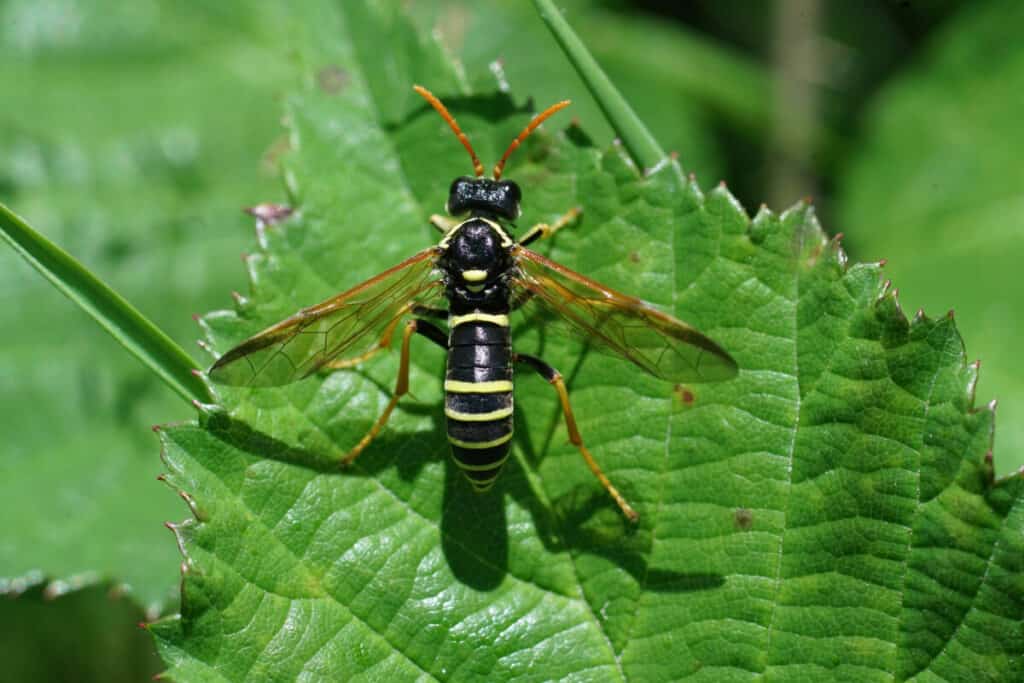With their sharp mandibles, sawflies can cause significant damage to plants, making them a common pest for gardeners and farmers.
In this article, we will explore what they are, their behavior, and ecological significance.
We’ll talk about how to treat and prevent their population growth, and also about natural predators that help control them.
What are sawflies?
Sawflies are a diverse group of insects that belong to the suborder Symphyta. They have elongated bodies with two pairs of wings and long antennae.
Sawflies have four distinct stages of development: egg, larva, pupa, and adult. These insects get their name from their saw-like ovipositors (egg-laying organs), which help them lay eggs inside plants.
What damage do sawflies cause on plants?
Larvae commonly consume leaf edges and can extensively chew the leaf blade down to the midrib.
Slug sawflies engage in windowpane feeding, where they chew leaf tissue on one surface of the leaf between the veins. Initially, the damaged leaves appear whitish, but over time, these affected areas turn brown.
How to identify sawflies on plants

Sawflies can be identified by their saw-like ovipositor, which helps them lay eggs inside plants. They have four distinct stages of development: egg, larva, pupa and adult.
Adult sawflies are usually black or grey and have two pairs of wings. Sawfly larvae look like small caterpillars and feed on the leaves of plants. They can cause significant damage to plants, making them a common pest for gardeners and farmers.
To identify sawflies on your plants, look for signs of windowpane feeding where they have chewed leaf tissue on one surface of the leaf between the veins; these areas initially appear whitish but later turn brown.
Read more:
How to get rid of sawflies
Handpick the larvae: If you have only a few plants affected by sawflies, you can manually remove the larvae from the leaves with tweezers or a vacuum cleaner.
Use neem oil: Neem oil is an organic insecticide that can kill young sawflies before they become adults and lay more eggs on your plants.
Use diatomaceous earth: Apply diatomaceous earth (DE) on your plants to provide a barrier that kills the larvae as they crawl over it. This natural insecticide is made from the fossilized remains of tiny aquatic organisms and is harmless to humans and animals.
Use insecticidal soap: Insecticidal soap is an effective way to treat plants for sawflies. It works by smothering the larvae and should be applied according to the instructions on the label.
Read more:
- How To Stop Insects Eating Plant Leaves
- How to Use Neem Oil and Save Your Plants
- How To Use Diatomaceous Earth In Potted Plants
- Insecticidal Soap vs Dish Soap for Pest Control
How to prevent sawflies on plants
- Use row covers to protect plants from sawfly infestations.
- Prune affected plants and discard the pruned material, as it may contain sawfly eggs or larvae.
- Plant trap crops, such as mustard or nasturtiums, to attract and trap adult sawflies before they can reach other plants in your garden.
- Introduce natural predators into your garden, including lacewings, ladybugs, and parasitic wasps which feed on sawfly larvae and eggs.
- Use yellow sticky traps near susceptible plants to monitor the population of adult sawflies in your garden and take necessary control measures if you find an infestation.
Host vegetable plants for sawflies
Some of the common vegetables affected by sawflies include cabbage, broccoli, cauliflower, kale, spinach, lettuce and celery.
Natural predators of sawflies
Sawflies have several natural predators that feed on them, including lacewings, ladybugs, ground beetles and parasitic wasps.
References
- https://extension.umn.edu/yard-and-garden-insects/sawflies
- https://hort.extension.wisc.edu/articles/sawflies/
- https://hortnews.extension.iastate.edu/sawflies

Fact Checked, Written, and Published by Kevin Rodrigues
Kevin is the founder of Gardening Mentor, a website that aims to teach people to grow their own food in a limited space. As a self-taught gardener, Kevin has spent several years growing plants and creating gardening content on the website. He is certified in Home Horticulture and Organic Gardening from Oregon State University. He has a Post Graduate Diploma in Horticulture and Landscape Gardening from Mumbai University.
Read more
